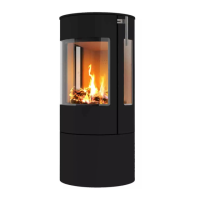
Do you have a question about the RAIS Viva 100 L Gas and is the answer not in the manual?
| Category | Stove |
|---|---|
| Fuel Type | Gas |
| Model | Viva 100 L Gas |
| Brand | RAIS |
| Number of Burners | 1 |
| Ignition Type | Electronic |
| Material | Steel |
| Color | Black |
| Gas Type | Natural Gas |
| Flue Outlet | Top or Rear |
Covers fire/explosion hazards and safe storage of flammable liquids.
Step-by-step instructions for responding to the smell of gas.
Emphasizes qualified installers and specific mobile home installation rules.
Details adherence to national and local gas/electrical codes for safe installation.
Specifies clearance, ventilation, and safe placement rules around the appliance.
Instructions for submerged parts and safe positioning to prevent burns.
Focuses on supervising children and preventing burns from hot surfaces.
Covers replacing guards and the need for qualified service personnel.
Explains the convection system, burner types, and variable heat output.
Covers gas types, installer qualifications, and manual retention.
Details balanced draught, room ventilation, and clearance requirements.
Explains how to locate the stove's unique production number for warranty.
Lists appliance certifications and maximum installation altitude.
Guidance on choosing a location and maintaining minimum clearances.
Requirements for gas line setup and adequate room ventilation.
Instructions for safely unpacking and leveling the stove.
Provides detailed measurements for safe distances from flammable materials.
Addresses floor load capacity and placement near flammable objects.
Installer task to mark the used venting system for record-keeping.
Details maximum allowed vent lengths and required vertical rise.
Table detailing horizontal run limits based on vertical rise for different flue sizes.
Specifies minimum vertical flue height and restrictor requirements.
Illustrates required clearances for twin pipe/concentric vent terminals.
Compares required clearances for Canadian and U.S. installations.
Guide for selecting correct pipe diameter based on length and gas type.
Methods for sealing and insulating the appliance in cold climates.
Instructions for modifying the flue outlet from top to rear.
Identifies specific nozzles for natural gas and LPG conversions.
Details the correct orientation for installing secondary burners.
Ensures proper ignition sequence between pilot and main burners.
Visual instructions for arranging decorative embers and logs.
Covers battery types, placement, and replacement for operation.
Step-by-step guide to pair the remote with the stove's receiver.
Verifying the ignition and operation of all burners.
Critical steps for checking gas inlet and burner pressures.
Emphasizes good ventilation and safety during the first use.
Covers wiring, battery warnings, and AC adapter usage.
How to enable or disable specific stove features via the remote.
Explains the remote's display icons and how to adjust temperature units and time.
Step-by-step guide to turn the stove on and off using the remote.
How to control the burner's flame intensity.
Specific method for switching between flame levels.
Instructions for setting and using the stove's countdown timer.
Describes how automatic temperature control and eco modes function.
Detailed steps for programming daily operating times and temperatures.
Explains the help function and behavior during power loss.
Visual checks for proper burner and pilot flame operation.
Procedures for cleaning injectors and inspecting the thermocouple.
Guidelines for inspecting the venting system for blockages and damage.
Steps for cleaning internal components during annual maintenance.
Instructions for external cleaning and care for sooty glass.
Detailed steps for accessing and replacing burner components.
Steps for downloading, setting up, and connecting the MyFire app.
Lists replacement parts for specific 'G' models.
Details individual gas unit components available as spare parts.